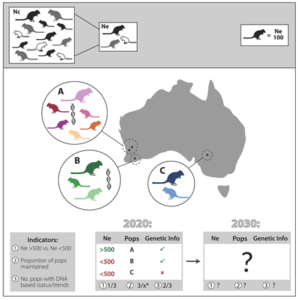|
One of the aims of the Genetic Composition Working Group (GCWG) is to support the integration of genetic data and monitoring into management and policy. Over the last year, the GCWG’s main focus has been the UN Convention on Biological Diversity (CBD), given the urgent need to improve the wording on genetic diversity in the post-2020 global biodiversity framework. The co-leads and members of the GCWG have been working to advocate for more actionable genetics targets, goals and indicators in the CBD framework, for all species (not just agricultural). This has included hosting seminars for CBD representatives, country and NGO focal points, attending CBD meetings, and developing peer-reviewed papers and policy-relevant documents for stakeholders in the CBD. For example, in partnership with G-BIKE (Genomic Biodiversity Knowledge for Resilient Ecosystems), we hosted five informational webinars for CBD focal points, reaching >100 attendees from about 40 countries. Related to this CBD focus, a group of GCWG members has reviewed the inclusion of genetic diversity in National Reports to the CBD from 57 countries. A policy summary of this work, including recommendations for future CBD reporting, is now available in 16 languages on the GEO BON GCWG website, and the full report is available as a preprint on BioRxiv: An analysis of genetic diversity actions, indicators and targets in 114 National Reports to the Convention on Biological Diversity. This will be available in a published journal within a few weeks. In addition, GCWG members have recently contributed as co-authors several relevant publications on the topic of monitoring genetic diversity, including:
Our group is also starting to engage with IPBES, by attending IPBES8 and IPBES8 Stakeholder Days, submitting a poster, and providing input on IPBES draft reports, including the recent draft on values assessment and draft on sustainable use of wild species (in collaboration with the Coalition for Conservation Genetics, mentioned below). Because of the high effort needed for CBD work and due to COVID-19, the group has not yet been able to focus on beginning a new round of GCWG projects. We plan to make a start on this over the next few months, along with scheduling an all hands working group meeting. Please reach out if you have ideas for a project. The GCWG co-leads would also like to mention the development of a Coalition for Conservation Genetics, whose goal is to better communicate and coordinate with other working groups in this field, including to help advance genetic diversity in the policy realm. Those groups include the IUCN SSC Conservation Genetics Specialist Group, G-BIKE, and Society for Conservation Biology. The development of this Coalition is still in progress, but more information will be coming soon. |
|
Related publications relevant to the WG:
|
 Fig 1. Presentation of genetic indicators in Hoban et al 2021. Hypothetical example demonstrating how indicators can be used to establish baseline and current levels of genetic diversity, and monitor this into the future to guide management decisions. Indicators 1 and 2 can be based on genetic data (effective population size [Ne] and genetically defined populations), or proxies (10% of census size [Nc] or geographic location). The top bar reminds the reader that Ne is much smaller than Nc and shows that each organism in the map represents an Ne of 100. *x is the historical baseline number of populations. Fig 1. Presentation of genetic indicators in Hoban et al 2021. Hypothetical example demonstrating how indicators can be used to establish baseline and current levels of genetic diversity, and monitor this into the future to guide management decisions. Indicators 1 and 2 can be based on genetic data (effective population size [Ne] and genetically defined populations), or proxies (10% of census size [Nc] or geographic location). The top bar reminds the reader that Ne is much smaller than Nc and shows that each organism in the map represents an Ne of 100. *x is the historical baseline number of populations. |
 Fig. 2. Panel A: Conceptual illustration of the proposed CBD genetic diversity indicator (Laikre et al., 2020, Hoban et al., 2020) using effective population size Ne > 500. Ne should be assessed (using genetic or demographic techniques or a rule of thumb) for ‘populations’ which may include single, isolated populations; metapopulations; or sub-areas of the total range. In the absence of robust genetic or demographic assessments allowing direct estimation of Ne, we suggest to use the proxy Ne/Nc = 0.1 Panel B: Histogram of 214 mean Ne/Nc ratios reviewed in Hoban et al. (2020) for (i) all taxa (grey, N = 214) and (ii) plants (green, N = 41). The dotted line indicates the threshold Ne/Nc value of 0.1 recommended in Hoban et al. (2020) in the absence of robust genetic or demographic data. More detail can be found in Hoban et al 2020. Fig. 2. Panel A: Conceptual illustration of the proposed CBD genetic diversity indicator (Laikre et al., 2020, Hoban et al., 2020) using effective population size Ne > 500. Ne should be assessed (using genetic or demographic techniques or a rule of thumb) for ‘populations’ which may include single, isolated populations; metapopulations; or sub-areas of the total range. In the absence of robust genetic or demographic assessments allowing direct estimation of Ne, we suggest to use the proxy Ne/Nc = 0.1 Panel B: Histogram of 214 mean Ne/Nc ratios reviewed in Hoban et al. (2020) for (i) all taxa (grey, N = 214) and (ii) plants (green, N = 41). The dotted line indicates the threshold Ne/Nc value of 0.1 recommended in Hoban et al. (2020) in the absence of robust genetic or demographic data. More detail can be found in Hoban et al 2020. |
A CBD-focused year for the Genetic Composition Working Group (GCWG)
News from: News from our network
